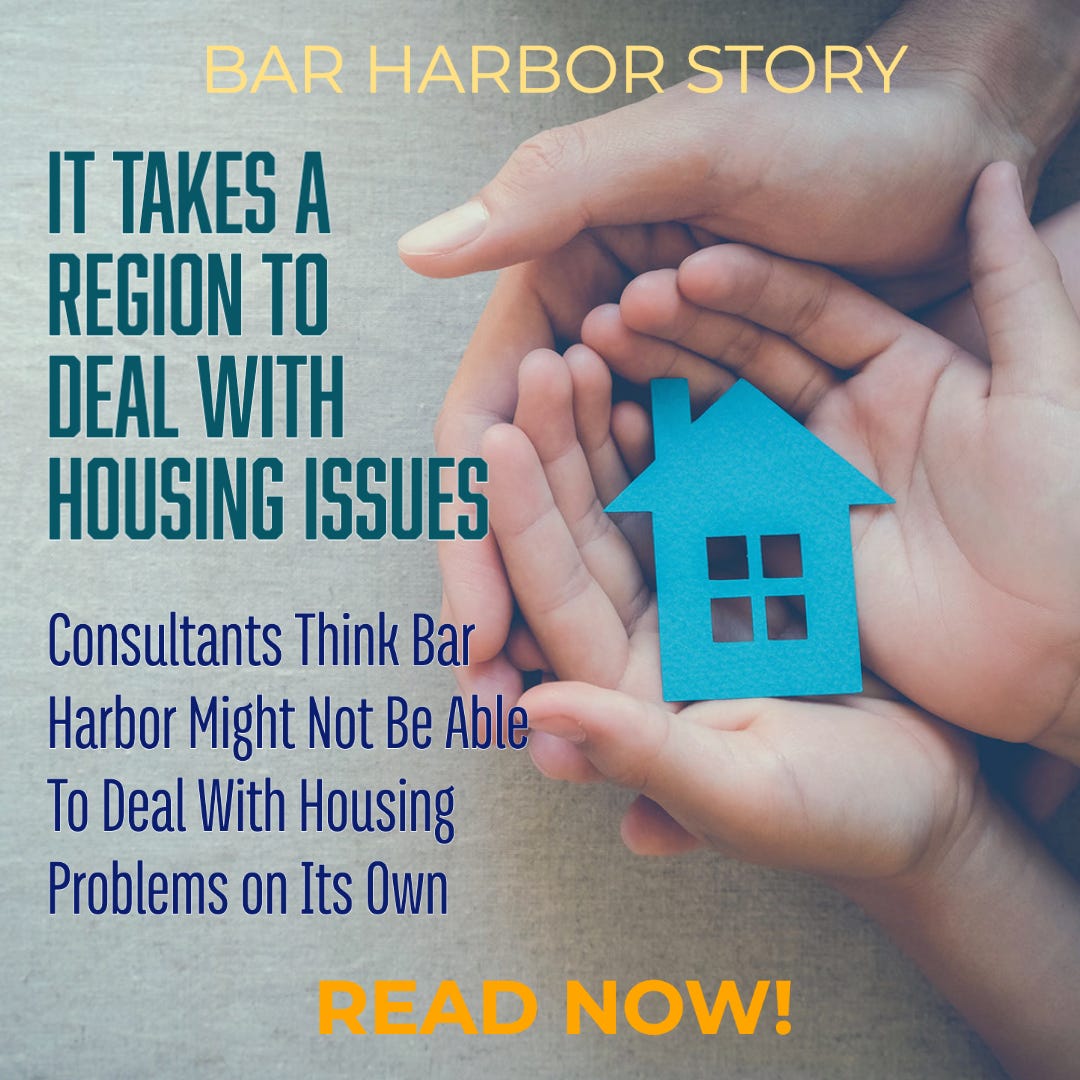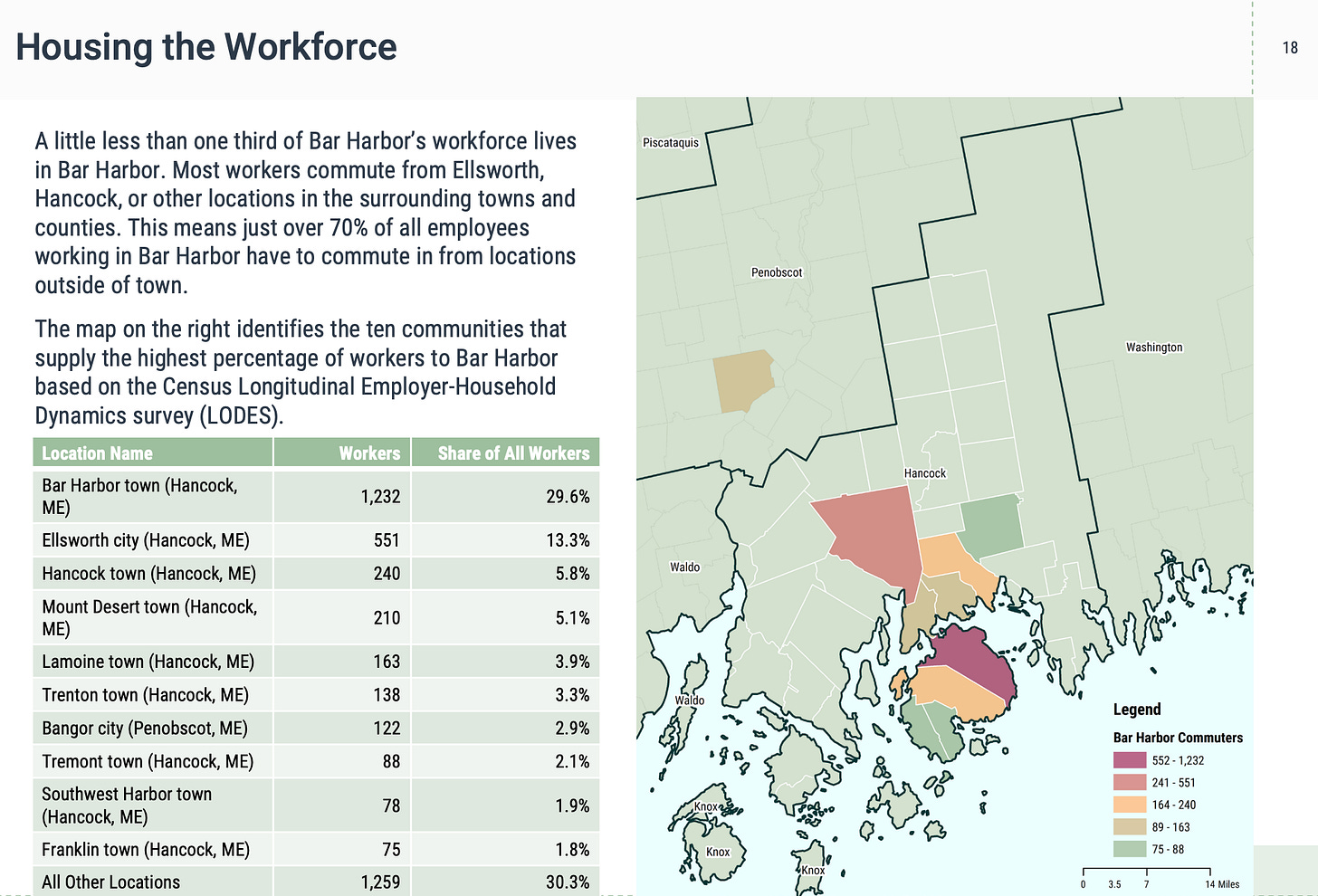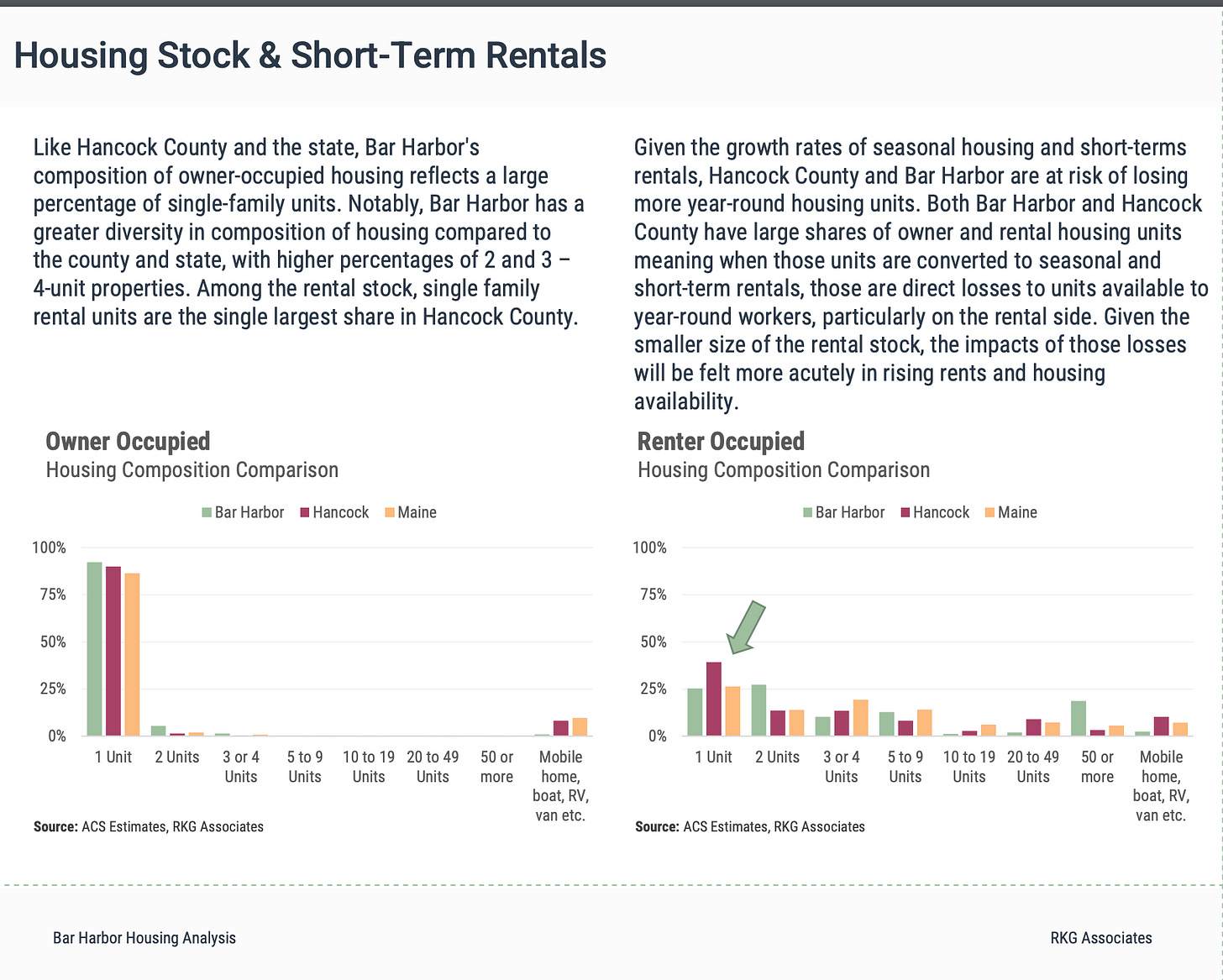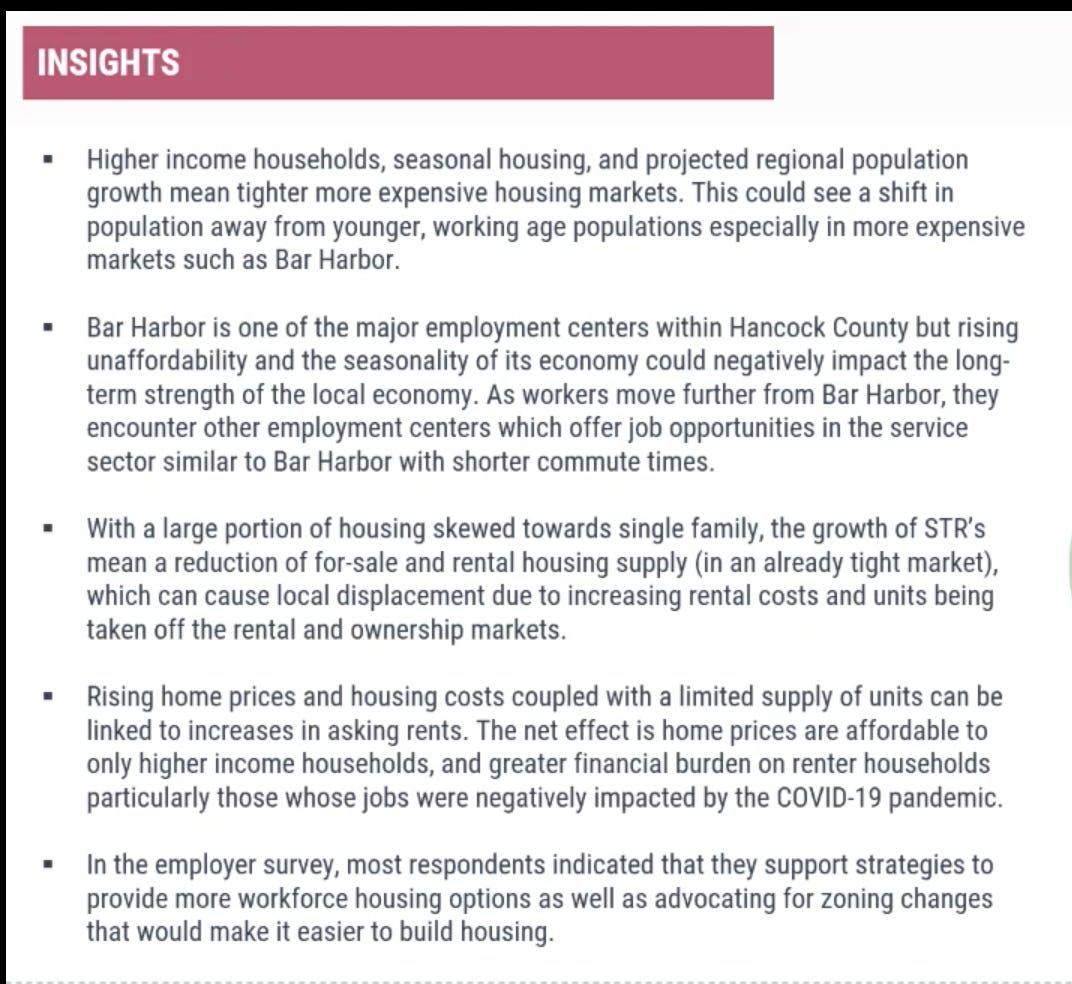It Takes a Region To Deal With Housing Issues
Consultants Think Bar Harbor Might Not Be Able To Deal With Housing Problems on Its Own
BAR HARBOR—Can Bar Harbor somehow make an additional 616 rental units by 2033? And an additional 94 owner-occupied housing units? Those are questions that the Comprehensive Planning Committee discussed Wednesday night as the consulting group RKG presented a housing analysis that is meant to inform Bar Harbor’s 10-year-plan for the future.
That projection is gleaned by U.S. Census data.
“There is a huge need” for housing, Erik Woyciesjes, a market analyst with RKG Associates said. He added that as things change that number could also change. Housing constraints could stymie the population increase, Woyciesjes said.
At over 80 pages, the Bar Harbor Housing Analysis which Woyciesjes and Eric Halvorsen, a RKG principal presented, delves into Bar Harbor’s housing stock, changing housing demographics, rental and housing trends, and more.
“This is just an inventory and analysis,” Gagnon told committee members and isn’t there to provide solutions to the area’s housing problems.
The report begins, “Bar Harbor’s Comprehensive Planning process has identified housing as one of the biggest issues facing the town of Bar Harbor and demands on the existing housing stock are facing pressure from several different segments of buyers and renters.”
Bar Harbor’s population has increased from 4,820 in 2000 to 5.527 in 2020. It’s projected that by 2038, it will have more than 6,000 residents, an increase of 15%. There is some degree of error in the sampling area, and it’s not a perfect science, but it’s still an increase that has supply constraints working against that projected growth.
Committee member David Woodside said that there are definitely more residents here than 40 years ago, but that increase didn’t feel as dramatic as it looked on the graph.
Halvorsen said a variety of economic and demographic factors drive up rental housing demand.
He and Woyciesjes see housing prices becoming unaffordable everywhere except in the most downtrodden markets where people don’t want to live. What he found the most interesting in Bar Harbor is that all the data is pointing toward people having to move further and further inland. If there’s no course correction there will be other jobs for people in the service industry closer to where they live. That means they could potentially leave their Bar Harbor jobs for ones in Ellsworth, Hancock, Bangor or Bucksport. “I said, ‘Oh man, that’s interesting and problematic.’”
Council Chair Valerie Peacock said that there was more nuance to the commuting question because Bar Harbor brings more money to the region. And it’s a bit of a Maine thing to drive more make more money. If Bar Harbor pays the best during certain economic times, then people will continue to commute to work in Bar Harbor.
Hancock County has the highest ration of seasonal housing compared to year-round housing, the report says. And Bar Harbor has one of the highest rates, but Mount Desert has the highest amount of seasonal housing.
Bar Harbor, Ellsworth, Bucksport, and Southwest Harbor all have the highest workforce density.
That matters because many of Bar Harbor workers live outside of Bar Harbor.
“Coastal Maine’s available supply of housing is tight,” Woyciesjes said. And a lot of respondents to the town’s employee housing survey this fall had a hard time finding their current residence and many said their home was too expensive, too small, and too far from work.
Bar Harbor has a higher diversity in types of property compared to the state, he said. The total number of short-term rental listings has notably increased. The rentals are also being consistently booked in 2020 and 2021. Rentals are consistently being filled. So the demand is there.
Higher cost communities such as Bar Harbor saw the higher home prices, but lower cost communities saw the greatest percent change in home cost. Bar Harbor has consistent rates that are comparable or higher for second homes and investment properties, the report said.
During public comment, real estate broker and former Planning Board member, Erica Brooks, said this region has a lot of cash sales so the mortgage data might not be accurate.
Lower and middle income households can’t afford Bar Harbor, Woyciesjes said.
HOUSING’S CHANGING DEMOGRAPHICS
Halvorsen said, “Housing is clearly an issue not just locally, but also regionally.”
He said he was happy with the relevant and qualitative data from the employers and employees survey. The housing challenges, he said, don’t just impact Bar Harbor, but also the region.
He told the committee members, “I’m not sure Bar Harbor can necessarily do this on its own.”
Committee Chair Kyle Shank said there was a chart in the presentation that had a disturbing fraction of people in Bar Harbor who had unsafe conditions. “I know that’s a bit outside of our purview.”
Gagnon said it’s very important to maintain the quality and safety of housing stock.
Town Council Chair Valerie Peacock asked about how seasonal workers fit into the data and asked if the need for an additional 616 housing units included seasonal workers. Halvorsen said that seasonal housing for seasonal workers is another layer. Woyciesjes said that some seasonal workers had responded to the employee survey. Employers of seasonal workers also responded to the town’s employer survey.
Woodside said he was struck by the need for 500 or 600 housing units needed, yet the town hasn’t found a place for even 100.
About ninety-four dwelling units were created in the last fiscal year, Town Planner Michele Gagnon said. “Creating housing is a very, very, very slow process in general and in Bar Harbor you can add a few more very very’s.” Those verys have to do with what some call a restrictive and burdensome Land Use Ordinance with about 40 zones, each with different rules and regulations for development.
In a tourist economy, you often have a housing imbalance when you are over-touristed, Gagnon said. The balance becomes between what’s needed for the resident and what’s needed for the tourist. What does that look like for Bar Harbor is an important question for Bar Harbor, she said.
2035 VISION STATEMENT
Part of the Comprehensive Planning Committee’s role is to create a vision statement to guide the town. Last month, the committee members were asked for input. Upon looking at the results, Gagnon added that what struck her is a need to look at economic sustainability and societal needs and the balance between tourism needs and year round needs.
Committee member, John Kelley, said that after 22 years in Bar Harbor, he still doesn’t understand what year-round means for a town that has two science labs, a hospital, a college, a national park. He said that he’s been involved in other conversations with other committees in town where people talk about year round, but don’t define the term.
What else do we want to have to call us year round? he asked. “A lot of people I know like the way it is because it’s not year round in the sense of visitors.” If the vision ends up promoting a year-round community, the committee may need to dig a bit more deeply and determine what does that term mean to one committee member as opposed to another.
Committee member Elissa Chesler suggested that diverse might be a better term than year-round.
Gagnon said it was a great point and she doesn’t think the comprehensive plan will solve the tourism questions but should provide general guidance adding, “We need to make sure we characterize things in a way that helps us move forward.”
“We’re ripping ourselves apart,” Peacock said about the town’s political climate and emphasized that collaboration and the word ‘and’ is more helpful than a ‘this or that’ mindset. “Where we are in this town right now is ‘ors.’ It’s this or that and never the two shall meet.”
Shank said that one or two things that get headlines are divisive and then they dominate the things that aren’t divisive.
Unless otherwise noted, all images are from the Bar Harbor Housing Analysis.
TO LEARN MORE
To read the report in full, go here. Also in the packet is the plan’s “Phase 1: Community Engagement Report,” which we’ll have an article on shortly.
To watch the two-hour meeting in its entirety on Town Hall Streams, click here.
Correction: I earlier said that Val Peacock said that making more money was a Maine thing and assumed that in the context people would realize that meant in relation to commuting. After talking to a reader, I don’t think that is clear enough and I’ve adjusted the wording of the sentence to “driving more to make more money.” Many thanks to the reader!






















